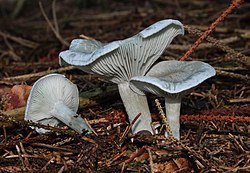Top Qs
Timeline
Chat
Perspective
Clitocybe odora
Species of fungus From Wikipedia, the free encyclopedia
Remove ads
Clitocybe odora, commonly known as the blue green anise mushroom,[2] or aniseed toadstool, is a blue-green mushroom that smells strongly like anise. It grows near deciduous and coniferous trees, in small groups alongside tree roots. This mushroom is edible but may resemble poisonous species.
Remove ads
Taxonomy
First described by the French mycologist Jean Baptiste Francois Pierre Bulliard (1742–1793). The specific epithet odora is from the Latin meaning "perfumed".[3]
Description
Young specimens have a bell-shaped cap with a light blue texture that fades to grey in age. The cap measures 3–8 centimetres (1–3 in) wide.[4] Mature specimens have blue-green, cup-shaped caps with a rough surface; the gills are adnate to decurrent and creamy white or blue-green.[2] The spore print is whitish to slightly pink.[5]
The stem is white to buff or cap-colored with no ring. It grows up to 6 cm (2+1⁄2 in) tall[4] and 2 cm thick.[2] The mushroom has a strong scent and taste of aniseed, hence its name. The odor is due to the presence of p-anisaldehyde and a small amount of benzaldehyde.[6]
There is a white variety (Clitocybe odora var. alba Lange) that has the same strong odour.
Similar species
Outside of Clitocybe, young specimens could be confused with Stropharia aeruginosa, in addition to other poisonous species.[7]

Remove ads
Distribution and habitat
Found in both deciduous, and coniferous woods, it is widespread in the temperate zones, occurring in Asia, Europe (August to December),[4] and North America (around August to November).[5] On the East Coast of North America it favours oak woodland, but it is often abundant in the coniferous forests of the Pacific Northwest.[2] It grows under trees and in debris.[5]
Edibility
The caps can be dried and used as a condiment, or used fresh for flavouring.[8] Mushroom hunters are advised to pick mature specimens, as the younger ones can be confused with several similar poisonous ones that grow with this mushroom. Every part of the mushroom should be examined before collecting for the table. Also, the stem and the cut cap should be checked to see if there are any fly larvae. Some guides recommend against eating the species.[7]
Remove ads
References
External links
Wikiwand - on
Seamless Wikipedia browsing. On steroids.
Remove ads





